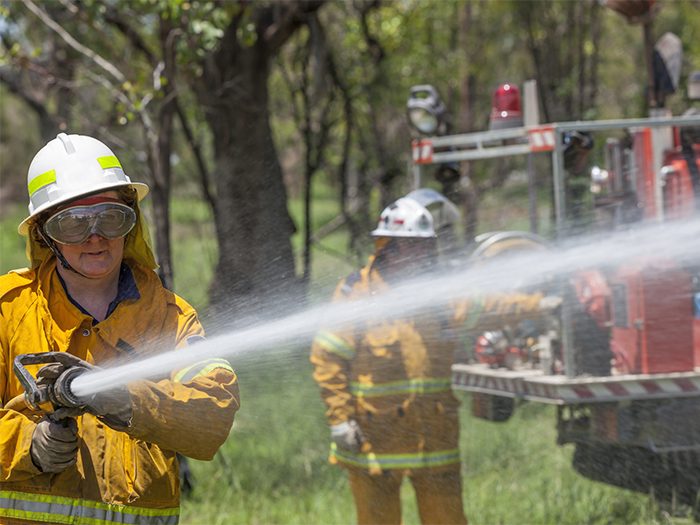Absence Management
Establishing Balance With Volunteers

If 2017 had a moniker, it might be “the year of the natural disasters,” thanks to a phenomenal array of catastrophic or severe events— hurricanes, tornadoes, wildfires, ice storms and floods.
Combined with smaller-scale fires and other emergencies, these incidents tax the resources of local and state emergency services, often prompting the need to call volunteer emergency responders into action.
But as lean as most organizations are already running, volunteer activities can sometimes cause friction between employees and employers. Handling conflicts the wrong way can potentially lead to legal headaches, harm employee morale and batter a company’s reputation.
State by State Variations
Most employers are aware of the various federal and state leave laws protecting their employees, including family and medical leave, pregnancy leave and military leave. But leave laws that protect the livelihoods of volunteer emergency responders are more likely to fly under the radar of some HR managers and risk managers.
Such laws don’t exist in every state, but more than 20 states do have some type of law in place to protect volunteers including emergency responders, firefighters, disaster workers, medical responders, ambulance drivers or peace officers.
The laws vary broadly. Nearly all specify that such leave be unpaid, and that employees disclose their volunteer status to employers and provide documentation for each leave. But there is a spectrum of variations in terms of what may trigger an eligible leave. Some, for instance, apply for any emergency that prompts a call from the volunteer’s affiliated responder group. Others may require a government declaration of emergency for the law to be triggered.
While many of the laws do not explicitly require employers to let employees leave work when called to an emergency during a shift, most specify that an employee may be late or even miss work entirely without facing termination or any other adverse employment action.
Some states mandate a maximum number of unpaid leave days that a volunteer can claim. But others may place more significant burdens on employers. In California, for instance, employers with 50 or more employees are required to grant up to 14 days of unpaid leave for training activities in addition to any leave taken to respond to emergency events. For multistate employers, keeping on top of what obligations may apply in each circumstance can be a challenge.
Significant Risks
Large or mid-sized employers may rely on absence management providers to keep them in compliance. For smaller employers though, it may be as simple as looking up a state’s law via Google to find out what’s required. However, checking in with the state department of labor or the company’s attorney may be the best way to get the correct facts.
“I would caution that just because you don’t find something [on the internet], it doesn’t mean it’s not there,” said absence management and employment law attorney Marti Cardi, vice president of Product Compliance for Matrix Absence Management.
For example, Cardi said, an obscure Texas law provides job-protected leave for volunteer ham radio operators called into service during an emergency.
Cardi said employers should task HR to investigate the laws in each state the company operates in, and to ensure that supervisors are educated about the existence of these laws.
“If a supervisor is told by one of his or her employees, ‘Sorry I’m not coming in today … I’ve been called to volunteer firefighter duty for the [nearby region] fire,’” she said, you want to be sure that the supervisor knows not to take action against the employee, and to contact HR for guidance.
“Training supervisors to be aware of this kind of absence is really important.”
An employer that does terminate a protected volunteer for responding to an emergency may be ordered to pay back wages and reinstate the employee. In some cases, the employee may also be able to sue for wrongful termination.
And of course, “you don’t want to be the company in the headlines that is getting sued because you fired the volunteer firefighter,” she added.
If an employer bars a volunteer from responding, the worst-case scenario may be a third-party claim. Failure to comply with the law could give rise to a claim along the lines of “‘If you had complied with your statutory obligation to give Jane Doe time to respond, my loved one would not have died,’” explained Philadelphia-based Jonathan Segal, partner at law firm Duane Morris and managing principal of the Duane Morris Institute.
“That’s the claim I think is the largest in terms of legal risk.”
Even if no one dies or is seriously injured, he added, “there could still be significant reputational risk if an individual were to go to the media and say, ‘Look, I got called by the fire department and I wasn’t allowed to go.’”
The Right Thing to Do
What employers should be thinking about, Segal said, is that whether or not you have a legal obligation to provide job-protected leave for volunteer responders, “there’s still the question of what are the consequences if you don’t?”
Employee morale should be factored in, he said. The last thing any company wants is for employees to perceive it as insensitive to their interests or the interests of the community at large.
“Sometimes employers need to go beyond the law, and this is one of those times,” — Jonathan Segal, partner, Duane Morris; managing principal, Duane Morris Institute
“How is this going to resonate with my employees, with my workforce, how are people going to see this? These are all relevant factors to consider,” he said.
There’s an argument to be made for employers to look at the bigger picture when it comes to any volunteer responders on their payroll, said Segal.
“Sometimes employers need to go beyond the law, and this is one of those times,” he said. “Think about the case where’s there’s not a specific state law [for emergency responders] and you say to a volunteer, ‘No, you can’t leave to deal with this fire’ and then people die. You as an employer have potentially played a role, indirectly, because you didn’t allow the first responder or responders to go,” he said.
The bottom line is that “it’s the right thing to do, even if it’s not required by law,” agreed Cardi.
“I feel that companies should have a policy that they’re not going to discipline or discharge someone for absences due to this kind of civic service, subject to verification of course.”
Clear Policy
While most employers do strive to be good corporate citizens, it goes without question that employers need to guard their own interests. It’s not especially likely that volunteer responders will try to take advantage of the unpaid leave allowed them, but of course, it could happen.
That’s why it’s important to have policies that are aligned with state laws. Those policies could include:
- Notifying the company of any volunteer affiliations either upon hire or as soon they are activated as volunteers.
- Requiring that employees notify a supervisor as soon as possible if called to an emergency (state requirements vary).
- Requiring documentation after the event from the head of the entity supervising the volunteer’s activities.
If at some point it becomes excessive – someone has responded to emergencies five times in nine weeks, then it’s time to examine the specifics of the law and have a discussion with the employee about what’s reasonable, said Segal. It may also be time to ask specifics about whether the person is volunteering each time, or are they being called.
In some cases, the discussion may need to be about finding a middle ground, especially if an employee has taken on an excessively demanding volunteer role.
“We encourage volunteers to pick the style that best fits their schedule,” said Greta Gustafson, a representative of the American Red Cross. “Disaster volunteers can elect to respond to disasters locally, nationally, or even virtually, and each assignment varies in length — from responding overnight to a home fire in your community to deploying across the country for several weeks following a hurricane.
“The Red Cross encourages all volunteers to talk with their employers to determine their availability and to communicate this with their local Red Cross chapter.”
Segal suggests approaching it as an interactive dialogue — borrowing from the ADA. “Employers may need to open a discussion along the lines of ‘I need you here this week because this week we have a deliverable on Friday and you’re critical to that client deliverable,’” he said, but also identify when the employee’s absence would be less critical.
No doubt there will be tough calls. An employer may have its hands full just trying to meet basic customer needs and need all hands on deck.
“That may be a situation where you say, ‘First let me check the law,’” said Segal. If there’s a leave law that applies, “then I’m going to need to comply with it. If there’s not, then you may need to balance competing interests and say, ‘We need you here.’” &










